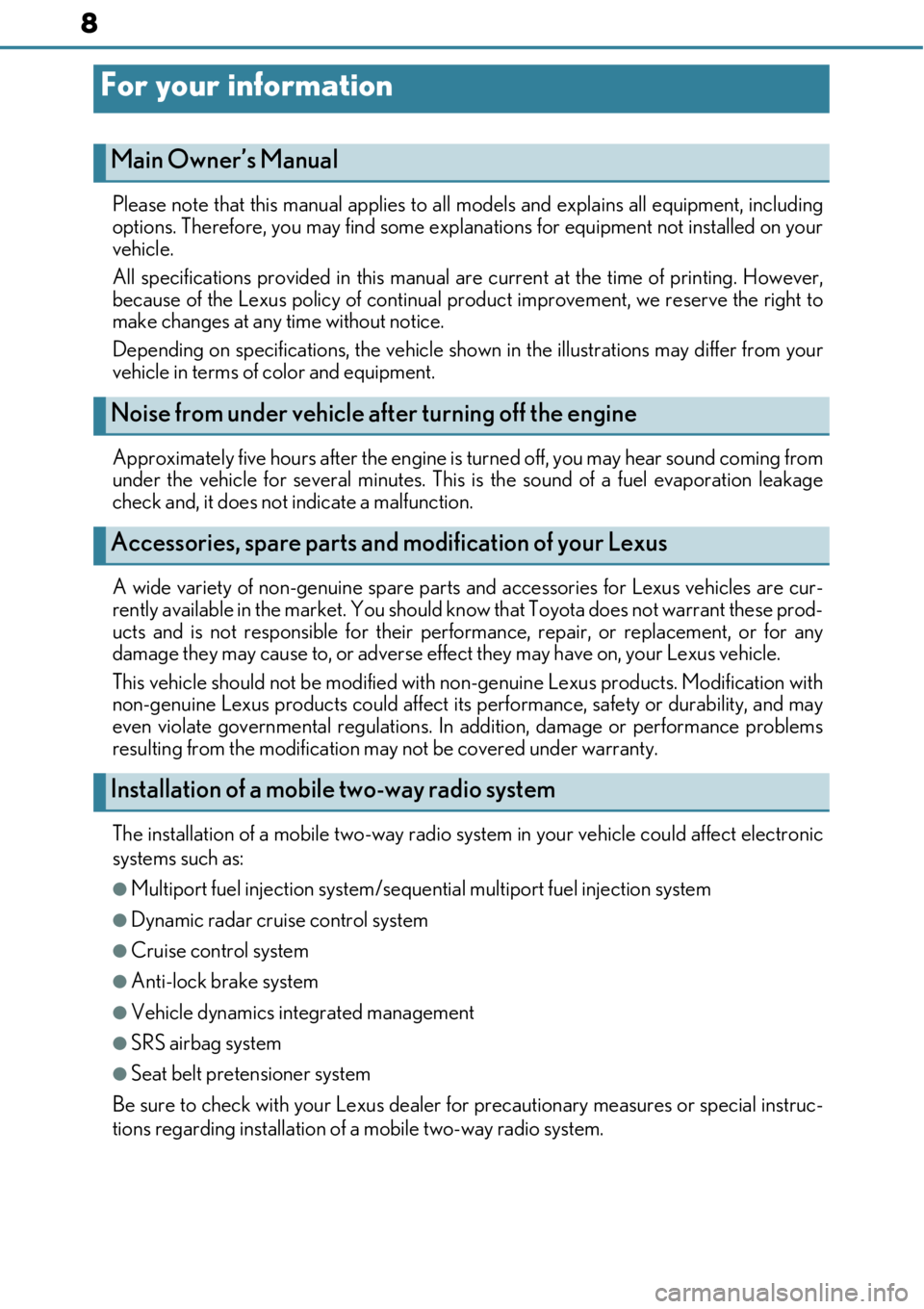ESP LEXUS RC F 2017 Owners Manual
[x] Cancel search | Manufacturer: LEXUS, Model Year: 2017, Model line: RC F, Model: LEXUS RC F 2017Pages: 724, PDF Size: 15.76 MB
Page 8 of 724

8
Please note that this manual applies to all models and explains all equipment, including
options. Therefore, you may find some expl anations for equipment not installed on your
vehicle.
All specifications provided in this manual are current at the time of printing. However,
because of the Lexus policy of continual pr oduct improvement, we reserve the right to
make changes at any time without notice.
Depending on specifications, th e vehicle shown in the illustrations may differ from your
vehicle in terms of color and equipment.
Approximately five hours after the engine is turned off, you may hear sound coming from
under the vehicle for several minutes. This is the sound of a fuel evaporation leakage
check and, it does not indicate a malfunction.
A wide variety of non-genuine spare parts and accessories for Lexus vehicles are cur-
rently available in the market. You should kn ow that Toyota does not warrant these prod-
ucts and is not responsible fo r their performance, repair, or replacement, or for any
damage they may cause to, or adverse effect they may have on, your Lexus vehicle.
This vehicle should not be modified with non-genuine Lexus products. Modification with
non-genuine Lexus products could affect its performance, safety or durability, and may
even violate governmental regulations. In addition, damage or performance problems
resulting from the modification may not be covered under warranty.
The installation of a mobile two-way radio system in your vehicle could affect electronic
systems such as:
●Multiport fuel injection system/seque ntial multiport fuel injection system
●Dynamic radar cruise control system
●Cruise control system
●Anti-lock brake system
●Vehicle dynamics integrated management
●SRS airbag system
●Seat belt pretensioner system
Be sure to check with your Lexus dealer for precautionary measures or special instruc-
tions regarding installation of a mobile two-way radio system.
For your information
Main Owner’s Manual
Noise from under vehicle after turning off the engine
Accessories, spare parts and modification of your Lexus
Installation of a mobile two-way radio system
Page 9 of 724

9
Your Lexus is equipped with several sophisticated computers that will record certain
data, such as:• Engine speed
• Accelerator status
•Brake status
• Vehicle speed
•Shift position
The recorded data varies according to the ve hicle grade level and options with which it is
equipped. These computers do not record conversations or sounds, and only record
images outside of the vehicle in certain situations.
●Data Transmission
Your vehicle may transmit the data recorded in these computers to Lexus without noti-
fication to you.
●Data usage
Lexus may use the data recorded in these computers to diagnose malfunctions, con-
duct research and development, and improve quality.
Lexus will not disclose the recorded data to a third party except:
• With the consent of the vehicle owner or with the consent of the lessee if the vehicle is leased
• In response to an official request by the police, a court of law or a government
agency
• For use by Lexus in a law suit.
• For research purposes where the data is not tied to a specific vehicle or vehicle
owner
●Usage of data collected through Lexus Enform (U.S. mainland only)
If your Lexus has Lexus Enform and if you have subscribed to those services, please
refer to the Lexus Enform Telematics Subs cription Service Agreement for information
on data collected and its usage.
●To learn more about the vehicl e data collected, used and shar ed by Lexus, please visit
www.lexus.com/privacyvts/.
Vehicle data recording
Page 10 of 724

10
This vehicle is equipped with an event data recorder (EDR). The main purpose of an EDR
is to record, in certain crash or near crash-like situations, such as an air bag deployment
or hitting a road obstacle, data that will a ssist in understanding how a vehicle’s systems
performed. The EDR is designed to record data related to vehicle dynamics and safety
systems for a short period of time , typically 30 seconds or less.
The EDR in this vehicle is desi gned to record such data as:
• How various systems in your vehicle were operating;
• Whether or not the driver and passenger safety belts were buckled/fastened;
• How far (if at all) the driver was depressi ng the accelerator and/or brake pedal; and,
• How fast the vehicle was traveling.
These data can help provide a better unde rstanding of the circumstances in which
crashes and injuries occur.
NOTE: EDR data are recorded by your vehicle only if a non-trivial crash situation occurs;
no data are recorded by the EDR under norm al driving conditions and no personal data
(e.g., name, gender, age, and crash location) are recorded. However, other parties, such
as law enforcement, could combine the EDR da ta with the type of personally identifying
data routinely acquired during a crash investigation.
To read data recorded by an EDR, special equipment is required, and access to the vehi-
cle or the EDR is needed. In addition to the vehicle manufacturer, other parties, such as
law enforcement, that have the special equipm ent, can read the information if they have
access to the vehicle or the EDR.
●Disclosure of the EDR data
Lexus will not disclose the data recorded in an EDR to a third party except when:
• An agreement from the vehicle’s owner (or the lessee for a leased vehicle) is obtained
• In response to an official request by the police, a court of law or a government
agency
• For use by Lexus in a law suit
However, if necessary, Lexus may:
• Use the data for research on vehicle safety performance
• Disclose the data to a third party for rese arch purposes without disclosing informa-
tion about the specific vehicle or vehicle owner
Event data recorder
Page 31 of 724

311-1. For safe use
1
For safety and security
WARNING
Observe the following precautions.
Failure to do so may cause the driver’s floor mat to slip, possibly interfering with the ped-
als while driving. An unexpectedly high spee d may result or it may become difficult to
stop the vehicle. This could lead to an ac cident, resulting in death or serious injury.
■When installing the driver’s floor mat
●Do not use floor mats designed for other models or different model year vehicles,
even if they are Lexus Genuine floor mats.
●Only use floor mats designed for the driver’s seat.
●Always install the floor mat securely using the retain ing hooks (clips) provided.
●Do not use two or more floor mats on top of each other.
●Do not place the floor mat bottom-side up or upside-down.
■Before driving
●Check that the floor mat is securely fixed in
the correct place with all the provided retain-
ing hooks (clips). Be especially careful to per-
form this check after cleaning the floor.
●With the engine stopped and the shift lever in
P, fully depress each pedal to the floor to
make sure it does not interfere with the floor
mat.
Page 42 of 724

421-1. For safe use
WARNING
■SRS airbag precautions
Observe the following precautions regarding the SRS airbags.
Failure to do so may cause death or serious injury.
●The driver and all passengers in the vehicle must wear their seat belts properly.
The SRS airbags are supplemental devices to be us ed with the seat belts.
●The SRS driver airbag deploys with considerable force, and can cause death or seri-
ous injury especially if the driver is very close to the airbag. The National Highway
Traffic Safety Administration (NHTSA) advises:
Since the risk zone for the driver’s airbag is the first 2 - 3 in. (50 - 75 mm) of inflation,
placing yourself 10 in. (250 mm) from your driver airbag provides you with a clear
margin of safety. This distance is measured from the center of the steering wheel to
your breastbone. If you sit less than 10 in . (250 mm) away now, you can change your
driving position in several ways:
• Move your seat to the rear as far as you can while still reaching the pedals com-
fortably.
• Slightly recline the back of the seat. Although vehicle designs vary, many drivers can achieve the 10 in. (250 mm) dis-
tance, even with the driver seat all the wa y forward, simply by reclining the back of
the seat somewhat. If reclining the back of your seat makes it hard to see the road,
raise yourself by using a firm , non-slippery cushion, or raise the seat if your vehicle
has that feature.
• If your steering wheel is ad justable, tilt it downward. This points the airbag toward
your chest instead of your head and neck.
The seat should be adjusted as recommended by NHTSA ab ove, while still maintain-
ing control of the foot pedals, steering whee l, and your view of the instrument panel
controls.
Page 43 of 724

431-1. For safe use
1
For safety and security
WARNING
■SRS airbag precautions
●The SRS front passenger airbag also deploys with considerable force, and can cause
death or serious injury especially if the front passenger is very close to the airbag. The
front passenger seat should be as far from the airbag as possible with the seatback
adjusted, so the front passenger sits upright.
●Improperly seated and/or restrained infant s and children can be killed or seriously
injured by a deploying airbag. An infant or child who is too small to use a seat belt
should be properly secured using a chil d restraint system. Lexus strongly recom-
mends that all infants and children be placed in the rear seats of the vehicle and prop-
erly restrained. The rear se ats are safer for infants and children than the front
passenger seat. ( →P. 58)
●If the seat belt extender has been connected
to the front seat belt buckles but the seat belt
extender has not also been fastened to the
latch plate of the seat belt, the SRS front air-
bags will judge that the driver and front pas-
senger are wearing the seat belt even though
the seat belt has not been connected. In this
case, the SRS front airbags may not activate
correctly in a collision, resulting in death or
serious injury in the event of a collision. Be
sure to wear the seat belt with the seat belt
extender.
●Do not sit on the edge of the seat or lean
against the dashboard.
Page 46 of 724

461-1. For safe use
■If the SRS airbags deploy (inflate)
●Slight abrasions, burns, bruising etc., may be sustained from SRS airbags, due to the
extremely high speed deployment (inflation) by hot gases.
●A loud noise and white powder will be emitted.
●Parts of the airbag module (steering wheel hub, airbag cover and inflator) as well as the
front seats, parts of the front and rear pillars, and roof side rails may be hot for several
minutes. The airbag itself may also be hot.
●The windshield may crack.
●For Lexus Enform Safety Connect subscribers, if the SRS airbags deploy or in the event
of a severe rear-end collision, the system is designed to send an emergency call to the
response center, notifying them of the vehicle’s location (without needing to push the
“SOS” button) and an agent will attempt to speak with the occupants to ascertain the
level of emergency and assistance required . If the occupants are unable to communi-
cate, the agent automatically treats the call as an emergency and helps to dispatch the
necessary emergency services. ( →P. 472)
WARNING
■Modification and disposal of SRS airbag system components
Do not dispose of your vehicle or perform any of the following modifications without
consulting your Lexus dealer. The SRS airb ags may malfunction or deploy (inflate)
accidentally, causing death or serious injury.
●Installation, removal, disassembly and repair of the SRS airbags
●Repairs, modifications, removal or replacement of the steering wheel, instrument
panel, dashboard, seats or seat upholstery, front, side and rear pilla rs or roof side rails
●Repairs or modifications of the front fender, front bumper, or side of the occupant
compartment
●Installation of a grille guard (bull bars, ka ngaroo bar, etc.), snow plows, winches or
roof luggage carrier
●Modifications to the vehicle’s suspension system
●Installation of electronic devices such as mobile two-way radios and CD players
●Modifications to your vehicle for a person with a physical disability
Page 47 of 724

471-1. For safe use
1
For safety and security
■SRS airbag deployment conditions (SRS front airbags)
●The SRS front airbags will deploy in the event of an impact that exceeds the set thresh-
old level (the level of force corresponding to an approximately 12 - 18 mph [20 - 30
km/h] frontal collision with a fixed wa ll that does not move or deform).
However, this threshold velocity will be cons iderably higher in the following situations:
• If the vehicle strikes an object, such as a parked vehicle or sign pole, which can move
or deform on impact
• If the vehicle is involved in an underride collision, such as a collision in which the
front of the vehicle “underrides”, or goes under, the bed of a truck
●Depending on the type of collision, it is possi ble that only the seat belt pretensioners will
activate.
●The SRS front airbags for the front passenger will not activa te if there is no passenger
sitting in the front passenger seat. However, the SRS front airbags for the front passen-
ger may deploy if luggage is put in the seat, even if the seat is unoccupied. (→P. 51)
■SRS airbag deployment conditions (S RS side and curtain shield airbags)
●The SRS side and curtain shield airbags w ill deploy in the event of an impact that
exceeds the set threshold level (the level of force corresponding to the impact force
produced by an approximately 3300 lb. [15 00 kg] vehicle colliding with the vehicle
cabin from a direction perpendicular to the vehicle orientation at an approximate
speed of 12 - 18 mph [20 - 30 km/h]).
●The SRS curtain shield airbags will depl oy in the event of vehicle rollover.
●The SRS side and curtain shield airbags will de ploy in the event of a severe frontal colli-
sion.
■Conditions under which the SRS airbags may deploy (inflate), other than a collision
The SRS front airbags, SRS side and curtain sh ield airbags may also deploy if a serious
impact occurs to the undersid e of your vehicle. Some exampl es are shown in the illustra-
tion.
The SRS curtain shield airbags may also deploy under the situations shown in the illustra-
tion.
●Hitting a curb, edge of pavement or hard sur-
face
●Falling into or jumping over a deep hole
●Landing hard or falling
●The angle of vehicle tip-up is marginal.
●The vehicle skids and hits a curb stone.
Page 98 of 724

982. Instrument cluster
■Speed indicator (F SPORT models)
When the vehicle reaches a set
speed, indicators will be displayed
on both sides of the displayed speed
unit.
The indicators will be displayed in
yellow (corresponding to a speed set
by a user) or red (fixed at 100 mph
[160 km/h])
*.
This setting can be enabled on the
multi-information display.
*: Always observe the legal speed limi t when driving on public roads.
■Rev indicator (F SPORT models)
When the engine reaches a set
speed, a ring-shaped indicator will
be displayed on the tachometer.
■Rev peak (F SPORT models)
The engine speed reaches or
exceeds 5000 rpm, an afterimage
of the tachometer will be displayed
at the highest engine speed for
approximately 0.5 seconds.
Page 105 of 724

1052. Instrument cluster
2
Instrument cluster
■Speed indicator
When the vehicle reaches the set
speed, the speed unit display will
turn yellow.
The indicators will be displayed in
yellow (corresponding to a speed set
by a user) or red (fixed at 100 mph
[160 km/h])
*.
This setting can be enabled on the
multi-information display.
*: Always observe the legal speed limi t when driving on public roads.
■Rev indicator (SPORT S mode/SPORT S+ mode)
When the shift lever is in M, an indi-
cator on the tachometer will be dis-
played in 3 steps. When the 3rd
level indicator is displayed, the indi-
cator will flash and a buzzer will
sound to notify you of shift-up timing.
The indicator may be displayed when
downshifting, depending on the
engine speed.
*: These illustrations show the default
meter display for SPORT S mode
and SPORT S+ mode. The meter dis-
plays for SPORT S mode and
SPORT S+ mode can be changed on
the settings display of the multi-infor-
mation display.
SPORT S mode*
SPORT S+ mode*